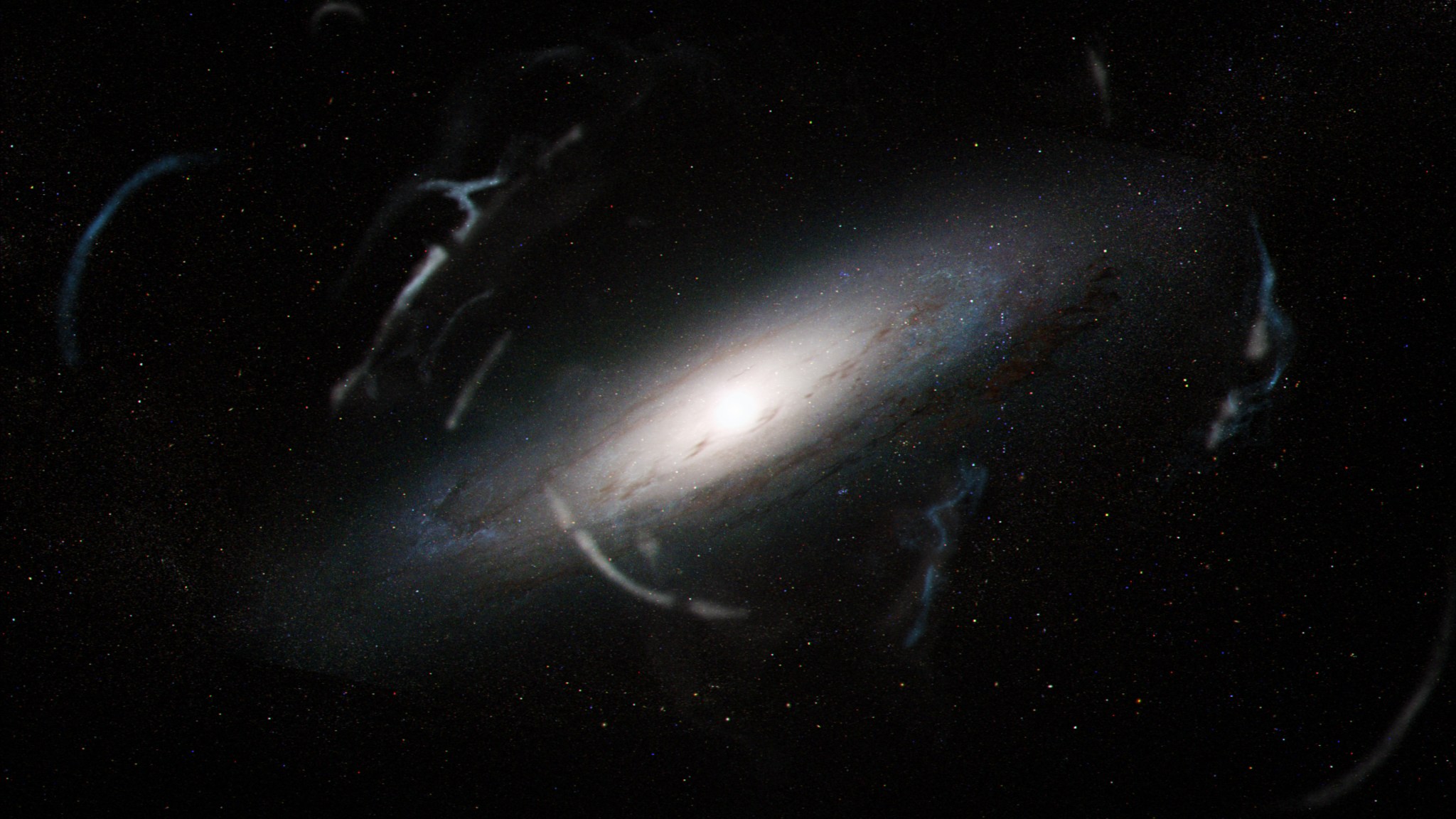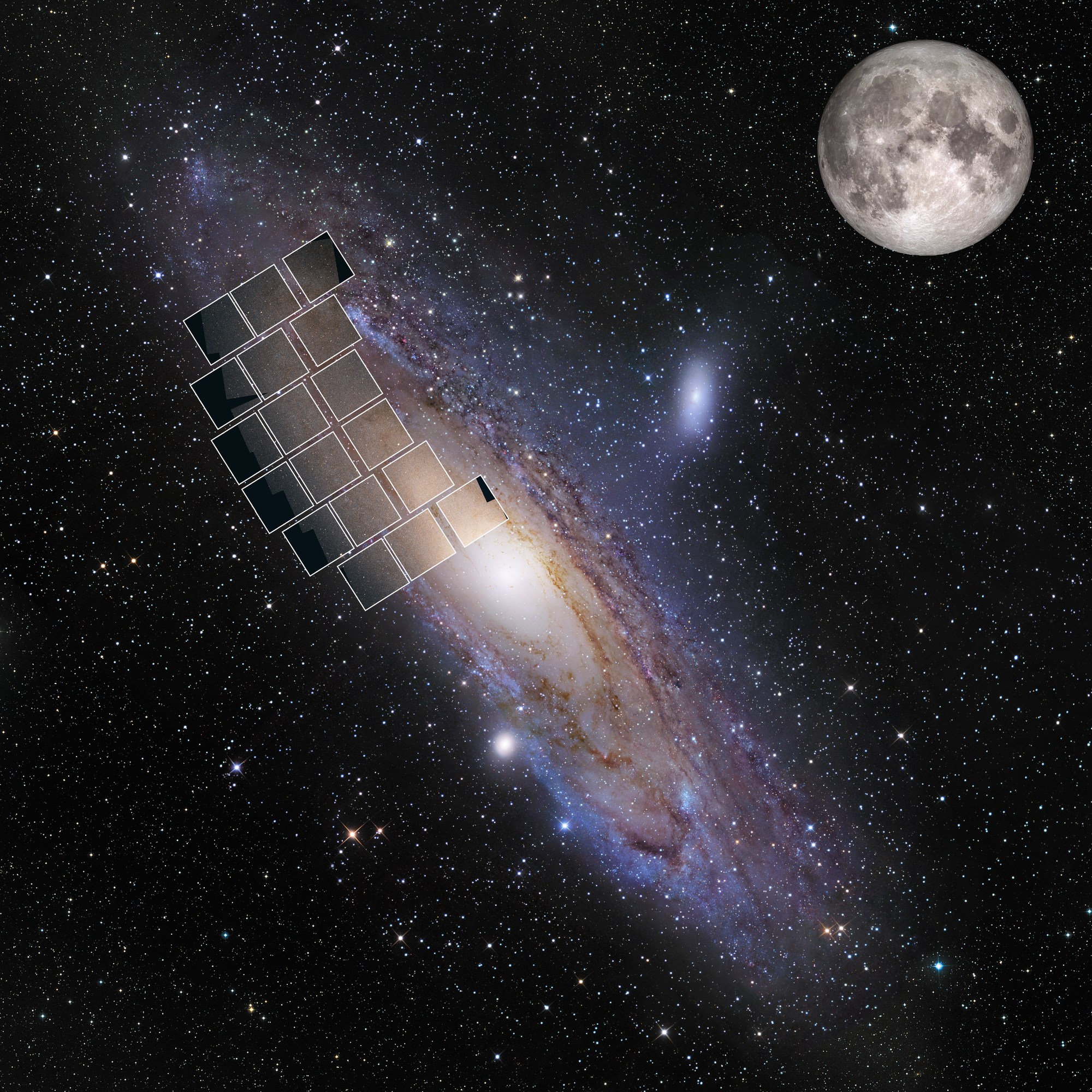NASA’s Roman to Search for Signs of Dark Matter Clumps

Some of the finest, smallest details in the universe – the gaps between elongated groups of stars – may soon help astronomers reveal dark matter in greater detail than ever before. After NASA’s Nancy Grace Roman Space Telescope launches, by May 2027, researchers will use its images to explore what exists between looping tendrils of stars that are pulled from globular clusters. Specifically, they will focus on the tidal streams from globular clusters that orbit our neighboring Andromeda galaxy. Their aim is to pinpoint a greater number of examples of these tidal streams, examine gaps between the stars, and ideally determine concrete properties of dark matter.
Globular cluster streams are like ribbons fluttering in the cosmos, both leading and trailing the globular clusters where they originated along their orbits. Their lengths in our Milky Way galaxy vary wildly. Very short stellar streams are relatively young, while those that completely wrap around a galaxy may be almost as old as the universe. A stream that is fully wrapped around the Andromeda galaxy could be more than 300,000 light-years long but less than 3,000 light-years wide.
With Roman, astronomers will be able to search nearby galaxies for globular cluster stellar streams for the first time. Roman’s Wide Field Instrument has 18 detectors that will produce images 200 times the size of the Hubble Space Telescope’s near-infrared camera – at a slightly greater resolution.
“Roman will be able to take a huge snapshot of the Andromeda galaxy, which simply isn’t possible with any other telescope,” shared Christian Aganze, the lead author of a recent paper about this subject and a postdoc at Stanford University in California. “We also project that Roman will be able to detect stars individually.”
Imagine the results: Roman’s vast, exquisitely detailed images will allow researchers to easily identify many examples of globular cluster streams in Andromeda. To date, astronomers using existing telescopes in space and on the ground have been limited to studying a slightly smaller number of globular cluster streams within our Milky Way.

Is Dark Matter Between the Stars?
Dark matter, which many assume to be a particle, can’t yet be observed directly, because it doesn’t emit, reflect, refract, or absorb light. If we can’t see it, how do we know it’s there? “We see dark matter’s effect on galaxies,” Aganze clarified. “For example, when we model how galaxies rotate, we need extra mass to explain their rotation. Dark matter may provide that missing mass.”
All galaxies, including the Milky Way, are surrounded by a dark matter halo. As astronomers glean more about the nature of dark matter, they may find evidence that a galaxy’s halo may also contain a large number of smaller dark matter sub-halos, which are predicted by models. “These halos are probably roughly spherical, but their density, sizes, and even if they exist isn’t currently known,” explained Tjitske Starkenburg, a co-author and a research assistant professor at Northwestern University in Evanston, Illinois.
Roman will redefine their search. “We expect dark matter to interact with globular cluster streams. If these sub-halos are present in other galaxies, we predict that we will see gaps in globular cluster streams that are likely caused by dark matter,” Starkenburg continued. “This will give us new information about dark matter, including which kinds of dark matter halos are present and what their masses are.”
Aganze and Starkenburg estimate that Roman will efficiently deliver the data they need within nearby galaxies – requiring only a total of one hour – and that these observations may be captured by the High Latitude Wide Area Survey.
Starkenburg will also help lay the groundwork for this investigation through her contributions to another project recently selected for funding by NASA’s Nancy Grace Roman Space Telescope Research and Support Participation Opportunities program. “This team plans to model how globular clusters form into stellar streams by developing a much more detailed theoretical framework,” she explained. “We’ll go on to predict where globular clusters that form streams originated and whether these streams will be observable with Roman.”
Aganze is also excited about other projects currently or soon coming online. “The European Space Agency’s Euclid mission is already starting to explore the large-scale structure of the universe, which will help us learn more about the role of dark matter,” he said. “And the Vera C. Rubin Observatory will soon scan the night sky repeatedly with similar goals. The data from these missions will be incredibly useful in constraining our simulations while we prepare for Roman.”
The Nancy Grace Roman Space Telescope is managed at NASA’s Goddard Space Flight Center in Greenbelt, Maryland, with participation by NASA’s Jet Propulsion Laboratory and Caltech/IPAC in Southern California, the Space Telescope Science Institute in Baltimore, and a science team comprising scientists from various research institutions. The primary industrial partners are Ball Aerospace and Technologies Corporation in Boulder, Colorado; L3Harris Technologies in Melbourne, Florida; and Teledyne Scientific & Imaging in Thousand Oaks, California.
By Claire Blome
Space Telescope Science Institute, Baltimore, Md.
Media Contact:
Claire Andreoli
NASA’s Goddard Space Flight Center, Greenbelt, Md.
301-286-1940
Christine Pulliam
Space Telescope Science Institute, Baltimore, Md.
Share
Details
Related Terms
First published at NASA.gov







